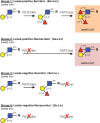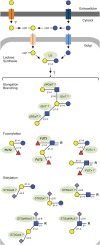Human milk oligosaccharides: every baby needs a sugar mama
- PMID: 22513036
- PMCID: PMC3406618
- DOI: 10.1093/glycob/cws074
Human milk oligosaccharides: every baby needs a sugar mama
Abstract
Human milk oligosaccharides (HMOs) are a family of structurally diverse unconjugated glycans that are highly abundant in and unique to human milk. Originally, HMOs were discovered as a prebiotic "bifidus factor" that serves as a metabolic substrate for desired bacteria and shapes an intestinal microbiota composition with health benefits for the breast-fed neonate. Today, HMOs are known to be more than just "food for bugs". An accumulating body of evidence suggests that HMOs are antiadhesive antimicrobials that serve as soluble decoy receptors, prevent pathogen attachment to infant mucosal surfaces and lower the risk for viral, bacterial and protozoan parasite infections. In addition, HMOs may modulate epithelial and immune cell responses, reduce excessive mucosal leukocyte infiltration and activation, lower the risk for necrotizing enterocolitis and provide the infant with sialic acid as a potentially essential nutrient for brain development and cognition. Most data, however, stem from in vitro, ex vivo or animal studies and occasionally from association studies in mother-infant cohorts. Powered, randomized and controlled intervention studies will be needed to confirm relevance for human neonates. The first part of this review introduces the pioneers in HMO research, outlines HMO structural diversity and describes what is known about HMO biosynthesis in the mother's mammary gland and their metabolism in the breast-fed infant. The second part highlights the postulated beneficial effects of HMO for the breast-fed neonate, compares HMOs with oligosaccharides in the milk of other mammals and in infant formula and summarizes the current roadblocks and future opportunities for HMO research.
Figures





References
-
- Abrahams SW, Labbok MH. Breastfeeding and otitis media: A review of recent evidence. Curr Allergy Asthma Rep. 2011;11:508–512. doi:10.1007/s11882-011-0218-3. - DOI - PubMed
-
- Albrecht S, Schols HA, van den Heuvel EG, Voragen AG, Gruppen H. CE-LIF-MS n profiling of oligosaccharides in human milk and feces of breast-fed babies. Electrophoresis. 2010;31:1264–1273. doi:10.1002/elps.200900646. - DOI - PubMed
-
- Albrecht S, Schols HA, van den Heuvel EG, Voragen AG, Gruppen H. Occurrence of oligosaccharides in feces of breast-fed babies in their first six months of life and the corresponding breast milk. Carbohydr Res. 2011;346:2540–2550. doi:10.1016/j.carres.2011.08.009. - DOI - PubMed
-
- Albrecht S, Schols HA, van Zoeren D, van Lingen RA, Groot Jebbink LJ, van den Heuvel EG, Voragen AG, Gruppen H. Oligosaccharides in feces of breast- and formula-fed babies. Carbohydr Res. 2011;346:2173–2181. doi:10.1016/j.carres.2011.06.034. - DOI - PubMed
-
- Andersson B, Porras O, Hanson LA, Lagergard T, Svanborg-Eden C. Inhibition of attachment of Streptococcus pneumoniae and Haemophilus influenzae by human milk and receptor oligosaccharides. J Infect Dis. 1986;153:232–237. doi:10.1093/infdis/153.2.232. - DOI - PubMed
Publication types
MeSH terms
Substances
Grants and funding
LinkOut - more resources
Full Text Sources
Other Literature Sources
Medical

